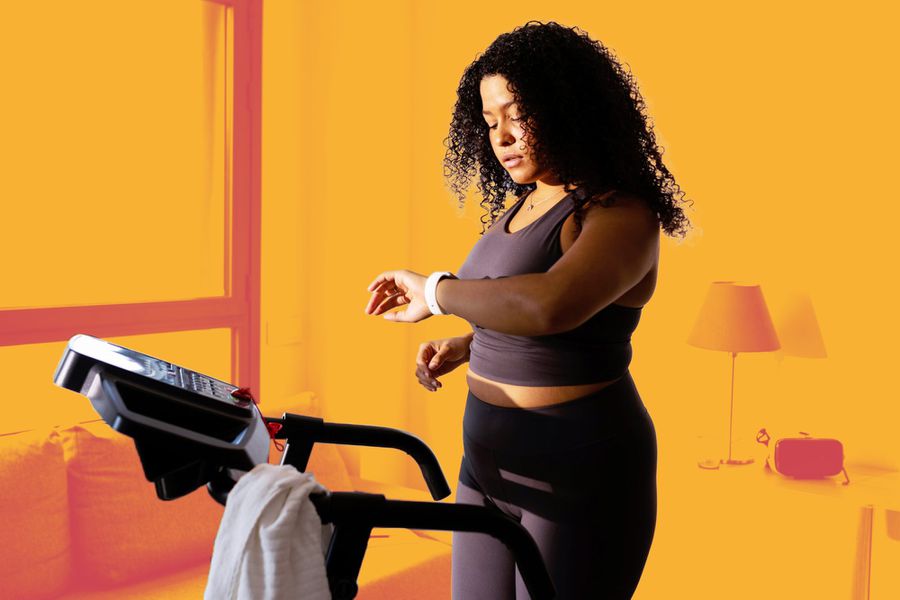
Personal trainer Harley Pasternak works with a slew of celebrities, including Ariana Grande, Lizzo, and Jessica Simpson, just to name a few. So when he shares workout tips on social media, it’s worth taking note. Recently, the trainer revealed some of his go-to advice on Instagram about how to “intelligently” work out on a treadmill, and it’s full of insider tips you’ll want to keep in mind.
In the clip, Pasternak performs a variety of movements on a treadmill in socks — something he confirmed in the caption that he only did to "show exaggeration in the different positions." In series of text, Pasternak suggested walking or running on your toes to strengthen your calves, doing lateral shuffles to work your abductors (the muscles that help the leg rotate to the side) and adductors (the muscles in the inner thighs that bring the legs to the center of the body), walking backward to improve your balance and strengthen your quads, and walking uphill to focus on your hamstrings and glutes.
Want to max out your next treadmill workout? Pasternak shared more details with Shape on why these moves are so efficient and how to do them. Here's what the celebrity trainer recommends for a smart treadmill workout.
Walk or Run On Your Toes
“Many people run flat-footed,” says Pasternak, adding, “This is a very inefficient way to run, and [it] puts more stress on the hips and the lower back.” But running on the toes allows the lower legs to absorb the shock for the rest of the body, and it optimizes the kinetic chain, he explains. The kinetic chain refers to “the interrelated groups of body segments, connecting joints, and muscles working together to perform movements and the portion of the spine to which they connect,” according to Ace Fitness. So, when the kinetic chain is optimized, you’re getting a more efficient workout.
Do a Lateral Shuffle
During everyday life and even during workouts, chances are you’re mostly moving forward and backward rather than side to side. “People spend so much time moving forward and back, they neglect lateral movements,” says Pasternak. This might not seem like a big deal, but neglecting lateral movement can lead to injury in some cases, as only working dominant muscles can make them stronger while smaller muscles stay the same, Tara Laferrara, a certified personal trainer, yoga teacher, founder of the TL Method, and co-owner of Compass Fitness, perviously told Shape. Doing lateral movements on the treadmill, such as lateral shuffles, engages your abductors and adductors, Pasternak adds.
Walk Backward
While most people walk and run on the treadmill facing forward, Pasternak suggests turning around and walking backward. This "improves balance and strengthens quads," he wrote in his Instagram post. It's also an opportunity to switch up your routine and give your body a new and unexpected movement to nail.
Walk Uphill
Pasternak recommends adding some elevation to your treadmill workout, so you’re walking uphill on an incline. “Walking uphill engages hamstrings and glutes a lot more than walking flat,” he says. “It also is a great way to reduce impact on your joints if you are running.” Strengthening these muscles is important, since they’re a part of the posterior chain, which refers to the muscles on the back of the body. The posterior chain includes some of the largest muscles in the body that are used in everyday activities, and keeping them strong helps protect against injuries, especially in the knees and back, Katrina Scott, certified personal trainer, nutrition coach, and cofounder of Tone It Up, previously told Shape.
Walk Uphill Backward
If you want to really challenge yourself, Pasternak suggests walking backward uphill. "Start off with an incline of four or five degrees and increase it over time to seven or eight degrees," he says. "This is a great way to build VMO strength and isolate your quadriceps." In case you're not familiar, VMO refers to the vastus medialis oblique muscle, which is located inside the front of your thighs.
In order to fit in a smart treadmill workout, you can also take note of some common mistakes that Pasternak recommends avoiding. One of his pet peeves is seeing people hold onto the handrail of the treadmill while walking on a high incline. "It's kind of counterintuitive," he says, as it takes some of the work out of the lower body. Pasternak also advises against using wrist and ankle weights. "They have a negative impact on your body's natural body mechanics and cause a dislocating effect on your joints," he says.
Whether you want to push yourself a little harder or are just looking to try something new, Pasternak's moves will definitely mix things up the next time you hop on the treadmill.



































